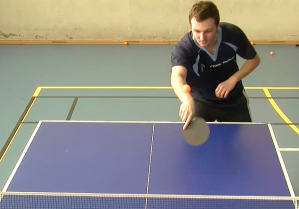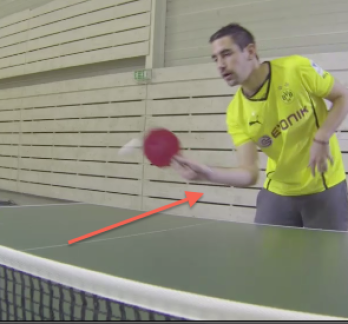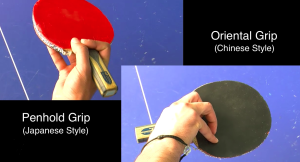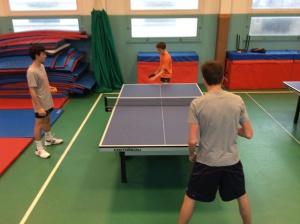Maintaining a good grip to facilitate your play
Find and keep a functional grip
Go from an unidentified grip to a stabilised Forehand (FH) or Backhand (BH) grip.
How you grip your racket has a direct influence on the quality of the racket-ball contact, as it sets the direction of the blade and stabilises the ball's trajectory. The position of your fingers and how tightly you squeeze the handle will change how useful and effective your grip is. There are, additionally, cultural forms associated with these grips. These are known as European or Oriental style grips. These techniques correspond to different styles of play and will direct the way in which you move. Whichever grip (or style) you choose, you will have to maintain it in order to produce every possible stroke, to guarantee all of the sensations arising from contact and to give you the possibility to transmit your energy into the ball, depending on the type of stroke. Table tennis players personalise these grips according to their bodies and their feel.
This video demonstrates an example of a non-functional backhand grip.
This table tennis player sends over a “windscreen wiper” backhand by playing with the thumb side of the racket, preventing him from varying how he opens up the blade.
When the ball comes quickly, he can cover it; this movement is therefore adapted.
If the ball comes over with backspin, this grip will prevent
him from returning it correctly.
Advice from the coach:
The video above shows you a technique that will help you return certain types of stroke.
This technique will only be effective in certain situations. It will therefore hold back the progression of this player over the long term.
Because of this, you must choose a grip that will give you more variety in terms of the blade angle (orthodox).
Below are 2 other non-functional grips.
Some students maintain the same grip no matter where the ball arrives onto their table (right, centre, left).
Other students use a certain grip for their return, and this becomes systematic. As such, we'll take a look at:
the shovel backhand
the frying pan forehand
the multi-finger or full hand forehand
 | Shovel backhand: The player jabs downwards which lifts the ball up when it arrives at speed |
Frying pan or spoon:
Staying front-side on to the ball, the player (adjusting the eyeball-racket) takes the ball early (after the bounce) with an open blade, from the bottom.
This second non-functional grip produces a high ball.
Several finger forehand:
There are also academic grips, which characterise a number of techniques and styles (playing systems):
the penhold grip (or Oriental),
the “shake-hand” grip (European).
The penhold or Oriental grips (Japanese/Korean or Chinese): On these images showing the backhand and forehand sides of the 2 penhold grip styles, we can see the different finger positions. These are, notably, straight for the Japanese and Korean and folded for the Chinese grips. Thanks to this positioning, they give a unique feel to the racket's grip, and either free up or straighten the wrist. |
Players using this grip use their forehand over 2/3 of the table, requiring a significant amount of leg speed.
However, players using the Chinese grip play with both sidesof the racket, providing a more even forehand-backhand balance. They also have a very deep service game.
The European or “shake-hand” grip
With this grip, players pinch the racket between the thumb and the index finger, folding the other fingers around the handle.
It is easier to balance the forehand with the backhand using this grip, but it does expose a vulnerability known as the crossover. This forces the player to move aside in order to maintain a suitable distance from the ball.

In order to try these out and choose your own grip, play a 3-way game and change grip for each stroke. You can do this: as a rally or as a match (counting the points) across the entire table (to combine forehand and backhand) or in a lateral zone (forehand or backhand) to make returns easier. |
You could also try to do it like these students: look at their grips, which don't prevent them from making any strokes, whether serving or attacking, even on the backhand side.
Using another angle, try doing strokes with these penhold (Oriental) grips.
As you can see, the grip is always the expression of how a table tennis player moves.
If the beginner stays with a certain way of holding his or her racket, limiting their ability to react when the ball's trajectory changes, the player with a more academic grip will combine this with their own play decisions and their own way of building and scoring points (the idea of a game plan).







